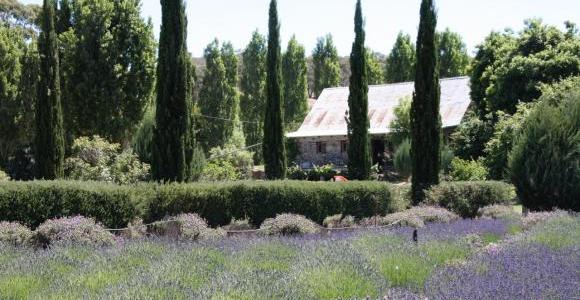
Lavandula, Shepherds Flat
You are here

On Thursday 11thDecember we set off on our Christmas trip to Daylesford and Hepburn Springs. The pre Christmas traffic was terrible and it took us longer than expected to reach Woodend where we stopped for morning tea. We then headed straight for Daylesford and our lunch venue.
Old Hepburn Hotel has been a focal point in Hepburn Springs since the Gold Rush days of the 1850’s. The current building was erected in 1911, after the original building was burnt down in a fire. One of the areas most popular attractions, we enjoyed a fabulous Christmas dinner while soaking up the relaxed atmosphere of a real country pub.
Not far down the road at Shepherds Flat is Lavandula, a Swiss Italian lavender farm, which is where we spent the afternoon.
In 1860 the Victorian government was offering smallholdings of land to encourage settlement here of former gold seekers and goldfields businessmen/women. Aquilino Tinetti established his farm on the hills and creek flats of Shepherds Flat, and returned to Biasca to farewell his family and to marry a bride, Maria Capriroli. Among many other Italian-speaking families here, they had thirteen children whose descendants still live in the district. Through changing dairying technology, floods and bushfire four generations of the Tinetti family continued to the present, now running Cricket Willow.
Twenty years ago, Carol White saw an auction sign that changed her life. Shepdale consisted of three Italian-built golden stone buildings that suggested to her that she could live in rural Australia but it would feel like Europe! She planted a European kitchen garden and trialled lavender. The 100-acre farm is now a local icon, growing lavender, olives and grapes, all of which is harvested and processed for use on the property.
There’s the garden, lavender fields, farmyard, the olive & chestnut groves, the vineyard - and in the distance the ancient volcano that delivered the good soil. The garden was designed to enhance Lavandula’s Italian style and seasonally grows food for the café.
Harvesting of the lavender occurs in January. The harvesters work along the rows of lavender bushes, take an armful of lavender, and saw through the stems with a hand sickle. The bunches are hung under the verandahs of the house to be dried by the heat of the metal roof. It looks and smells divine. The flowers are winnowed to remove the flower heads from the stem, sieved, and packed into eye pillows, sleep pillows and culinary lavender. Fresh lavender is sold as bunches or distilled to make our lavender water and lavender oil, which goes into many of the hand-made body products sold in the farms’ rustic shop.
The gardens provide a wonderful place to sit and contemplate and enjoy the beauty of nature.
The rustic charm of the farm buildings reflects the European heritage.
We were able to purchase a few last minute Christmas gifts in the well stocked produce shop before our long trip back to Melbourne. The trip was a great success and was a lovely way to end our year.








